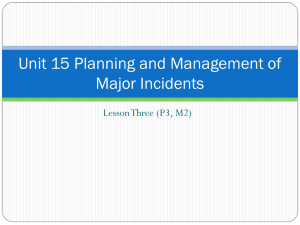msword
advertisement
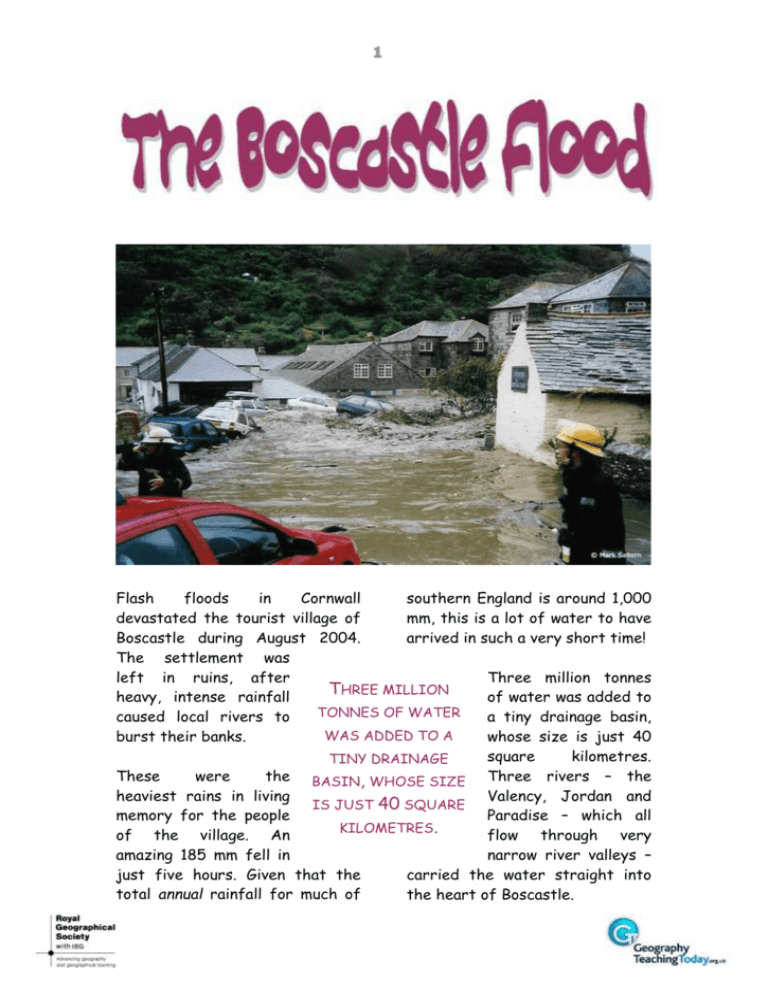
1 Flash floods in Cornwall southern England is around 1,000 devastated the tourist village of mm, this is a lot of water to have Boscastle during August 2004. arrived in such a very short time! The settlement was left in ruins, after Three million tonnes T HREE MILLION heavy, intense rainfall of water was added to TONNES OF WATER caused local rivers to a tiny drainage basin, WAS ADDED TO A burst their banks. whose size is just 40 square kilometres. TINY DRAINAGE These were the BASIN, WHOSE SIZE Three rivers – the heaviest rains in living Valency, Jordan and IS JUST 40 SQUARE memory for the people Paradise – which all KILOMETRES. of the village. An flow through very amazing 185 mm fell in narrow river valleys – just five hours. Given that the carried the water straight into total annual rainfall for much of the heart of Boscastle. 2 OTHER PHYSICAL FACTORS THAT HELPED FLOODING TAKE PLACE The soils were already saturated from previous rainfall earlier in the week, encouraging overland flow to begin even sooner. The three river valleys are very steep and narrow. A broader floodplain would have helped to soak up water and river energy more effectively. The steep valley sides mean that soils are thin, with limited water storage capacity when heavy rain comes. The parent material is old, hard sandstone with limited permeability. The rivers here are naturally ‘flashy’. Surrounding vegetation includes agricultural land with limited interception storage, although there is some forestry along the riverbanks. (So conditions would have been even worse, without these patches of woodland!) The rain coincided with high tide in the bay. This restricted the rate of exit of floodwater into the harbour. The first signs of danger came at 2 p.m. on 16th August, when cast iron manhole covers in the town’s streets began to shudder, indicating that forceful storm waters were gathering in the sewers beneath. By mid-afternoon, the Valency and Jordan had over-topped their Emergency services in action banks. At 5 p.m. the Clovelly Clothing shop was dragged 50 metres away from its site by floodwater flowing down the main street before later collapsing. As evening fell, soaked locals and holidaymakers huddled together in the village sports hall for warmth while helicopter winches lifted stranded home-owners off the roofs of their own houses. 3 WHAT WAS THE IMPACT FLOODING ON LOCAL OF THE PEOPLE? The presence of people living in this area resulted in a hazard risk becoming present. Around 1,000 people live in Boscastle. The rainfall also hit at a holiday time of year when the settlement’s population doubles to 2,000 - as tourists arrive, many of who are following the South West Coast Path. swept out of kitchens as water entered properties. Six properties collapsed entirely. The muddy interior of a bar Other impacts included: Remains of a car in the bay Much higher levels of motor vehicle damage were also experienced, as a result of this arrival. In addition, shops were carrying greater levels of stock than at other times of the year. Happily, no one died but property damage was high. At least thirty cars were washed straight into the harbour and many more were left upturned and badly damaged. A three-metre high wave of water was reported to have crashed through one street at 80 kilometres per hour. Fridgefreezers were picked up and Infrastructure disruption - Both bridges in the village were destroyed and sections of road were swept away. Telephone, water, electricity and gas supplies were all interrupted. Irreplaceable loss of historical artefacts - The ‘Witch Museum’ – which is fifty years old and receives 50,000 visitors a year – had some of its unique contents damaged. Physical injury No-one died, but at least one resident suffered a heart attack. Mental injury Many residents suffered stress and anxiety in the year that followed. It was six months before many properties were sufficiently repaired for homeowners to permanently return home. 4 HOW RESILIENT DID THE PEOPLE OF BOSCASTLE TURN OUT TO BE? very much as if the people of Boscastle have picked themselves up after the flood and resumed “business as usual.” What does this tell us about human societies and their ability to recover from natural hazards and disasters? A building collapses in 2004 Boscastle bounced back. You can visit the village website and see how life has returned to normal since the terrible floods of 2004. http://www.boscastlecornwall.org .uk/ shows you what life here today is like. If you look gallery” it images of 2004. Otherwise, at the “flood picture shows more amazing the devastation of however, IS it looks Adapted from “Geography in the News” (by Dr Simon Oakes) Photographs for the original article were taken by firefighter Richard Bluett and Station Officer Mark Saltern. View more images of the flood at http://www.geographyinthenews.r gs.org/member/newscasestudies/ article/default.aspx?id=306 Photographs are also by Brian Holland www.boscastleoldmill.com and David Flower at website www.tintagelweb.co.uk GLOBAL WARMING TO BLAME? The historical record shows that Boscastle has always been a hazardous environment and prone to steep rises in river levels after heavy rain. However, recent events are more severe than any other event on record. Could global warming be a culprit? Increasingly, many scientists believe so. Flash floods have always been a feature of the UK’s climate, located as we are along a “battle zone” where tropical air comes into contact with cold polar air. Whenever these two air masses converge, storms can occur as the warmer, less dense tropical air rises above the colder air and rapidly condenses to form rain. However, global warming makes the potential for extreme storm damage greater. If tropical air masses are warming, in response to climate change, then their ability to hold moisture is increasing (water vapour content is determined by the amount of heat energy available). This means the volume and intensity of frontal rainfall that is released over the UK may now be increasing. 5 Extra notes for teachers supporting teaching of the Boscastle case study The Boscastle flood carries an important lesson – human societies should expect that unexpected things will sometimes happen. Rounding off teaching of this first part of the Unit, encourage students to think about reasons why, as a society, we can’t always prepare for everything. Why might a worse flood visit a place that scientists ever expected? After brainstorming, prompt students with the following possible reasons: Records don’t go back far enough to know what to expect in the future Incomplete knowledge of how the weather works Climate change is making the weather even more unpredictable Computer predictions don’t always work Unexpected events can occur, such as tsunamis, meteors, volcanoes (there are films they may have seen) If time permits, broaden this into a discussion of the following – could you still keep your cool “under fire” if something happened that was way beyond expectations, like the Boscastle flood? Or would you panic? How might you help calm down other people if they were panicking? Film clip resources of Boscastle flooding in 2004 http://www.skycast.com/video/watch/-1029766214858349788/ or http://news.bbc.co.uk/player/nol/newsid_4150000/newsid_415560 0/4155688.stm?bw=bb&mp=wm&news=1&bbcws=1#
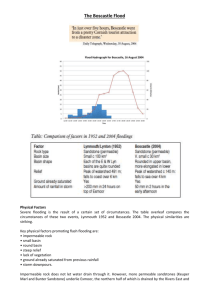
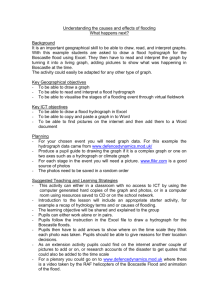
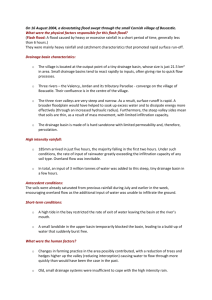

![My Flood Project [WORD 624KB]](http://s3.studylib.net/store/data/007180649_1-37937117fa0d9f223031a6f75d9a4179-300x300.png)

